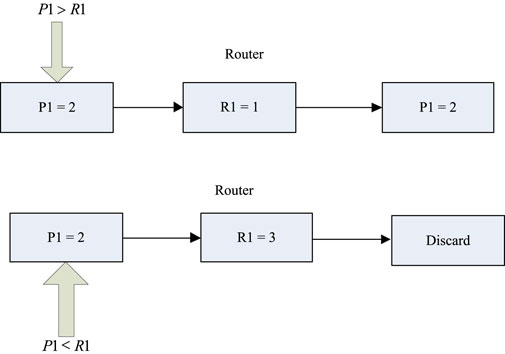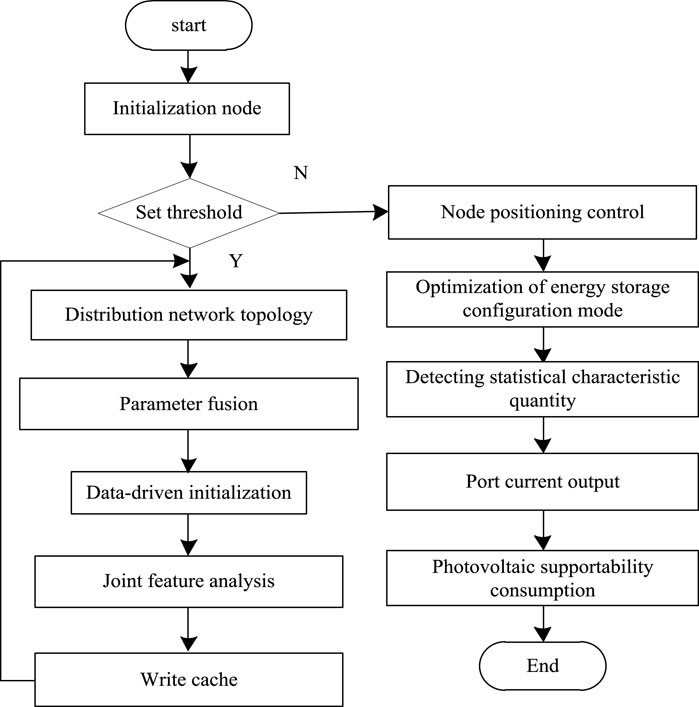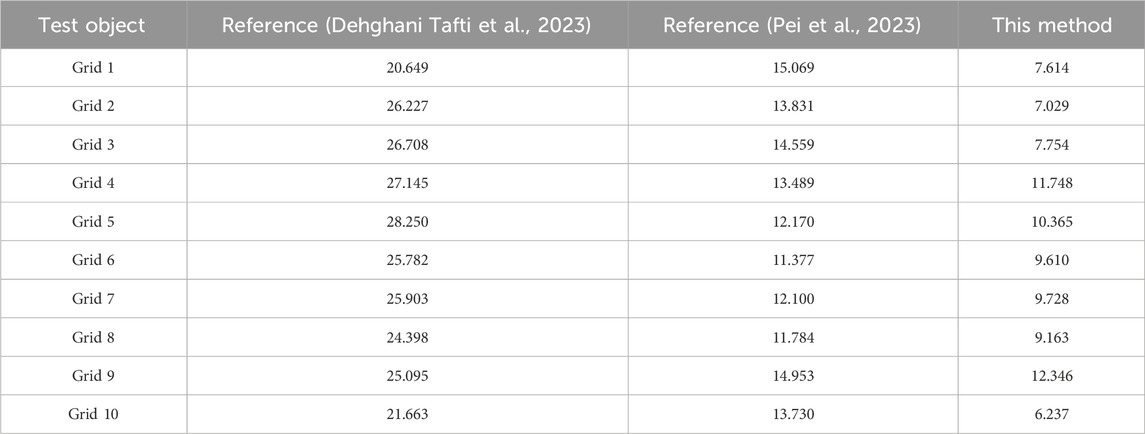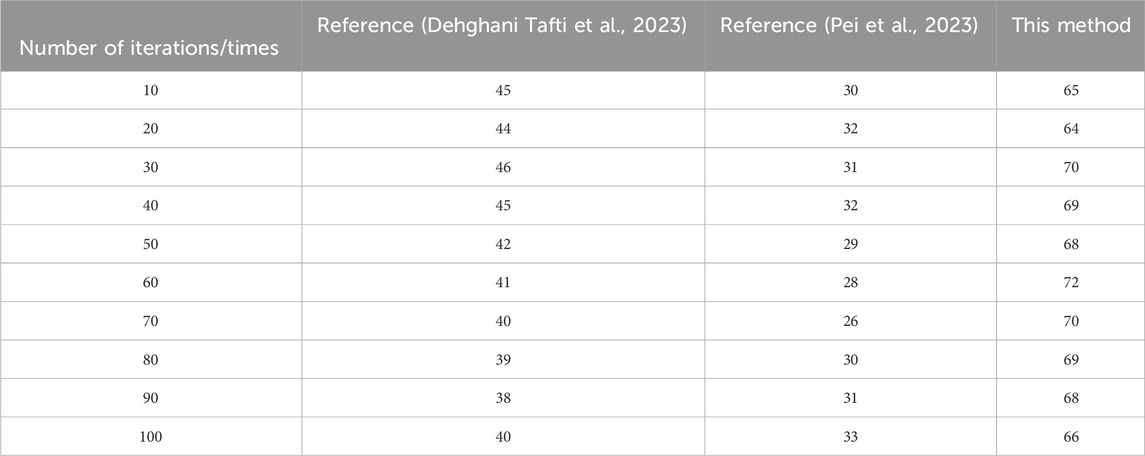- State Grid Shanxi Electric Power Company Yuncheng Power Supply Company, Yuncheng, China
In order to improve the control capability of distributed photovoltaic support, a distributed photovoltaic support consumption method based on energy storage configuration mode and random events is proposed. A networked and constrained parameter analysis model for distributed photovoltaic power supply control was constructed. Based on the direct flexible mode of optical storage, an AC/DC voltage level control model for distributed solar power supply control was constructed. In the operation mode of DC hybrid distribution network, the demand response tracking identification method was used to analyze the uncertain characteristic parameters of distributed solar power supply load, and combined with the planned energy storage capacity parameters, the distributed solar power supply load and photovoltaic output were estimated. By configuring the optimal energy storage capacity, adjusting the power distribution of the microgrid, and integrating the analysis of uncertain factors and random events in the energy storage configuration mode, the design of distributed photovoltaic support consumption has been achieved. The experimental results show that the distributed photovoltaic absorption control using this method has lower load requirements, can effectively reduce the exchange power of the interconnection line, and improve the configuration scale, system reliability, and economy of the photovoltaic energy storage system.
1 Introduction
With the popularization of distributed energy and power grid, people pay more attention to the research on distributed photovoltaic indemnificatory consumption. According to the energy characteristics of different regions and actual application scenarios, a distributed photovoltaic indemnificatory consumption model is established to reduce energy expenditure and improve the management level of distributed photovoltaic efficient consumption system structure and operation mode (Wang Chun et al., 2023). By theoretical analysis and experimental research, the research on distributed photovoltaic supportability consumption control under the constraints of energy storage configuration mode and random events is realized. According to the advantages analysis of power quality, power supply reliability and return on investment, the joint characteristic analysis method of photovoltaic power generation, energy storage coordination and DC mode is adopted to realize the comparative analysis of the cost and surplus grid access mode, and the dynamic analysis model of distributed photovoltaic supportability consumption is established. Combined with the dynamic scheduling of distribution network participants in major leagues (Zhihui et al., 2022). According to the analysis of the common characteristics of distribution network operators and multi-microgrids, the control ability of distributed photovoltaic supportability can be improved, and the adaptive control of consumption can be realized through the analysis of the cost of large alliance cooperative game mode. The research on related distributed photovoltaic supportability consumption methods is of great significance in promoting the clean energy construction of power grid and optimizing the network design (Xiang et al., 2021).
At present, the distribution scheme of Nash negotiation distribution mechanism is used to establish a distributed photovoltaic supportability consumption model, and the cooperative surplus is distributed by dynamic coupling control method. Combined with the analysis of the planar organizational structure characteristics of distribution network operators and multi-microgrid, the power flow parameter analysis model of load supply is constructed to improve the stability of distributed photovoltaic support. In reference (Dehghani Tafti et al., 2023), a distributed photovoltaic supportability consumption model based on the analysis of distribution network power flow and source-load uncertainty characteristics is proposed. The dynamic characteristics analysis of distribution network security and loss is adopted to realize the elimination of photovoltaic supportability, but this method has a big error in the analysis of two-stage stochastic optimization model. Reference (Pei et al., 2023) proposes a photovoltaic grid supportability consumption method based on the retail electricity price mechanism, which realizes photovoltaic supportability consumption control according to the transmission network loss estimation and the setting of the electrical distance between the two parties. However, this method has poor reliability in detecting and scheduling the source-load uncertain parameters of photovoltaic microgrid and low accuracy in detecting the source-load uncertain output (Yunfeng et al., 2016).
In response to the above issues, this article proposes a distributed photovoltaic guaranteed consumption method based on energy storage configuration mode and random events. The article considers the randomness of distributed photovoltaic systems themselves, and also delves into the impact of energy storage configuration modes, market electricity prices, electricity demand, and other external random events on system operation. At the same time, the article combines the analysis of planned energy storage capacity parameters to establish a load and photovoltaic output estimation model for distributed photovoltaic supporting consumption. This model can comprehensively consider the uncertain characteristic parameters of renewable energy output, provide accurate load and photovoltaic output prediction information for the system, and provide important support for the optimal configuration of energy storage equipment and the stable operation of the system. Experimental tests have shown that the method used in this article has good convergence in distributed photovoltaic consumption control, with a maximum load demand of only 12.346 KW and a lower load demand. It can effectively reduce the exchange power of parallel lines, improve the configuration scale, system reliability, and economy of photovoltaic energy storage systems.
2 Networking and constraint parameter analysis model of distributed photovoltaic supportability consumption control
2.1 Networking model of distributed photovoltaic supportability consumption control
In order to realize the construction of distributed photovoltaic indemnificatory consumption model with energy storage configuration mode and random events, firstly, the network structure model of distributed photovoltaic indemnificatory consumption control is constructed, and the network parameter analysis model is established by considering the risk loss model parameter analysis of multi-microgrid, combining with the participant benefit settlement and market clearing analysis (Zou et al., 2018). When the energy storage battery needs to meet the charging and discharging power constraints, the distribution of distributed photovoltaic indemnificatory consumption control nodes is obtained as shown in Figure 1.
According to the distribution model of the distributed photovoltaic power supply control nodes shown in Figure 1, the load characteristics of users, and the power scheduling method, and based on the power consumption characteristics of users, a scheduling priority model for distributed photovoltaic power supply water is obtained, as shown in Formula 1:
where,
where,
2.2 Analysis of constraint parameters of distributed photovoltaic supportability consumption
In the operation mode of DC hybrid distribution network, the characteristic parameters of source-load uncertainty in the process of distributed photovoltaic consumption are analyzed by demand response tracking identification method, and the target weight of load correlation after demand response is constructed by combining with the parameter analysis of planned energy storage capacity, as shown in Formula 3:
In order to avoid the shadowing caused by the linear normalization of index values, the cluster analysis is carried out on n consumption elements of distribution network in the kth floor, and the parameters of demand response dynamic allocation model are obtained according to the discount electricity price analysis in normal and valley periods, as shown in Formula 4:
Considering the demand response and the uncertainty of source and load, the inertia dynamic distribution variables
However, due to the convergence of the initial electricity price and the initial load, it is obtained that the outer capacity distribution of the energy storage system meets
According to the above analysis, in the operation mode of DC hybrid distribution network, the characteristic parameters of source-load uncertainty in the process of distributed photovoltaic consumption are analyzed by demand response tracking identification method, and the load and photovoltaic output estimation model of distributed photovoltaic supportability consumption is established by combining with the parameter analysis of planned energy storage capacity (Yunfeng et al., 2021).
3 Distributed photovoltaic supportability consumption optimization
3.1 Load and photovoltaic output estimation of distributed photovoltaic supportability consumption
With the objective function of guiding the main body of microgrid to meet the power flow constraints, the load and photovoltaic output estimation model of distributed photovoltaic indemnificatory consumption is established (Chen et al., 2022). In order to ensure the safety and economic benefits of distribution network, the framework structure of point-to-point electric energy transaction of distribution network is constructed, as shown in Figure 2.
Since microgrid may be distributed at different nodes in the distribution network, if the fitness function of dynamic programming under the second-stage income distribution mechanism is set, then in the sense of first-order Taylor approximation, the distribution network has the ability of reactive power optimization, and the distribution network node set is obtained by using the dynamic subspace fusion mechanism, and the nearby
3.2 Distributed photovoltaic supportability consumption and optimization of energy storage configuration mode
The distribution matrix of energy storage equipment charging and discharging satisfying constraint conditions is introduced as shown in Formula 7:
wherein,
According to the above analysis, the parameters of the capacitor bank operation model are analyzed, and the operation goal of the microgrid surplus on-grid mode is to maximize the distribution weight matrix
where,
According to the fusion analysis of uncertain factors of energy storage configuration mode and random events (Zhang et al., 2019), the design of distributed photovoltaic supportability is realized, and the data amount of regional network adjustment is obtained as shown in Formula 10:
wherein,
wherein,
The speed and position of particle
(1) Speed update formula:
wherein,
(2) Position-based update formula as shown in Formula 13:
wherein,
In each iteration, the velocity and position of the particles are updated according to the above formula, until the maximum number of iterations is satisfied, the iteration is stopped, and the global optimal solution is output (Ge et al., 2022; Rekioua, 2023; Zhou et al., 2024).
And the design of distributed photovoltaic supportability is realized according to the fusion analysis of energy storage configuration mode and uncertain factors of random events. The implementation flow is shown in Figure 3.
4 Experimental test
In order to verify the performance of this method in realizing distributed photovoltaic indemnificatory consumption control, experimental tests are carried out. The distribution dimension of electromagnetic parameters of distribution network is 120, the characteristic coefficient of winding that microgrid can’t match at the same time is 0.25, the power frequency excitation coefficient is 0.182, the minimum load is 14267 MW, the reliability index parameter of historical output sequence is 0.034, the coil current at Tk time is 24 mA, and the confidence level is 0.95. See Table 1 for the analysis model of driving parameters of photovoltaic distribution network.
According to the experimental scenes and parameter settings in Tables 1, 2, the simulation experiment of distributed photovoltaic supportability consumption estimation is run, and the consumption control results under different configuration model parameters are given, as shown in Figure 4.

Figure 4. Results of consumption control under different configuration model parameters. (A) m=4, τ=12. (B) m=4, τ=15. (C) m=4, τ=10. (D) m=5, τ=10.
From the analysis of Figure 4, it is known that the optimal configuration parameters of consumptive energy storage are m = 4 and m = 10 considering the installed capacity, energy storage capacity and comprehensive cost of the system. On this basis, different methods are adopted to realize the consumptive convergence analysis of distributed photovoltaic protection, and the comparison results are shown in Figure 4. And the convergence value is not as ideal as the method in this paper.
From the analysis of Figure 5, it is known that the method in this paper has good convergence in distributed photovoltaic consumption control, and the load demand is tested, and the comparison results are shown in Table 3.
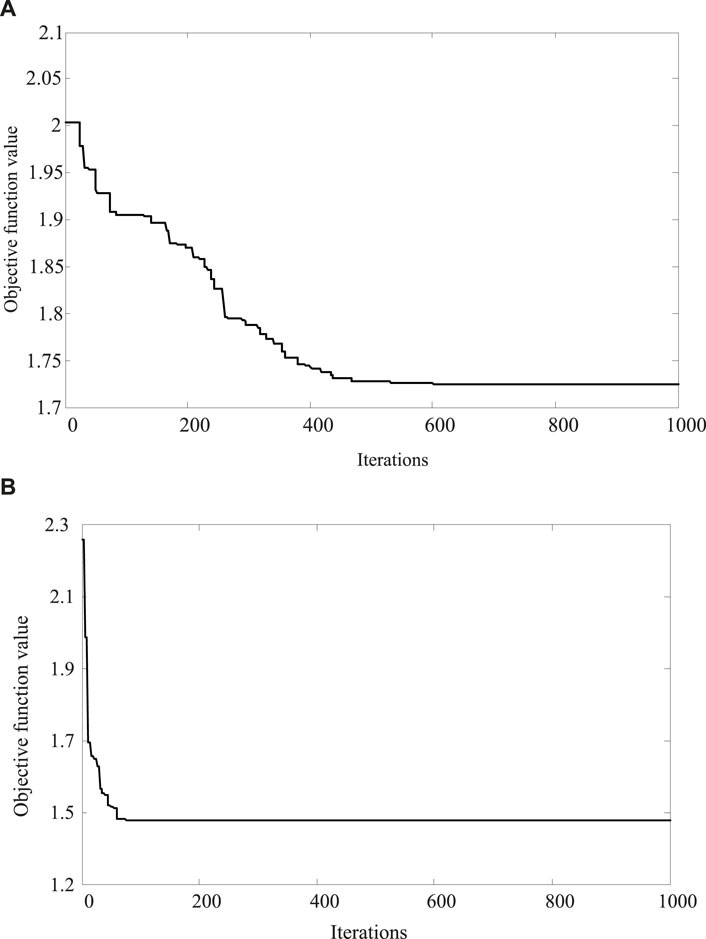
Figure 5. Comparison of convergence of consumption control with different methods. (A) Traditional method. (B) This method.
According to Table 3, the highest load demand of this method is only 12.346 KW, while the highest load demand of literature (Dehghani Tafti et al., 2023) and literature (Pei et al., 2023) is 28.250 KW and 15.069 KW. It shows that the load demand of this method is low, which can effectively reduce the exchange power of parallel lines, and improve the configuration scale, system reliability and economy of photovoltaic energy storage system.
To further verify the effectiveness of this method, the reduction rate of exchange power will be analyzed, and the results are shown in Table 4 below.
According to Table 4, the highest reduction rate of this method reached 72%, while the highest load demand of literature (Dehghani Tafti et al., 2023) and literature (Pei et al., 2023) reached 46% and 32%. Moreover, with the increase of iterations, the reduction rate of the method fluctuates slightly, but remains stable overall, indicating that the method can maintain good performance in many cases. This shows that the method proposed in this paper is more effective in optimizing the energy management and energy storage configuration of distributed PV systems.
5 Conclusion
This article proposes a distributed photovoltaic guaranteed consumption method based on energy storage configuration mode and random events. A networked control model for distributed photovoltaic guaranteed consumption was constructed, combined with the direct flexible mode of optical storage, and an AC/DC voltage level control model was established. The demand response tracking method of DC hybrid distribution network was used to analyze the uncertainty characteristic parameters of source load. A load and photovoltaic output estimation model was established based on the planned energy storage capacity parameters. To address the uncertainty of renewable energy output, allocate the optimal energy storage capacity to adjust the power distribution of microgrids. By integrating the energy storage configuration mode with the uncertainty factors of random events, the optimization design of distributed photovoltaic guaranteed consumption has been achieved. By integrating the energy storage configuration mode with the uncertainty factors of random events, this method can adapt to different operating conditions and demand changes, and has high flexibility. The experimental results show that the method has good convergence in distributed photovoltaic consumption control, with a maximum load demand of only 12.346 KW and a low load demand. The maximum reduction rate of the method proposed in this paper reaches 72%, and although the reduction rate fluctuates slightly with the increase of iteration times, it remains stable overall, indicating that the method can maintain good performance in various situations. Although the method proposed in this article performs well in reducing the exchange power of interconnection lines and improving the self-sufficiency of distributed photovoltaic systems, configuring a larger capacity energy storage system may increase the initial investment cost of the system. Cost benefit analysis is a key factor to consider in practical applications.
Data availability statement
The raw data supporting the conclusions of this article will be made available by the authors, without undue reservation.
Author contributions
YC: Writing–original draft, Writing–review and editing. GY: Writing–original draft, Writing–review and editing. YY: Writing–original draft, Writing–review and editing. YZ: Writing–original draft, Writing–review and editing. TZ: Writing–original draft, Writing–review and editing. XC: Writing–original draft, Writing–review and editing.
Funding
The author(s) declare that financial support was received for the research, authorship, and/or publication of this article. Supported by the Science and Technology Project of State Grid Shanxi Electric Power Company: Research on Key Technologies of Distributed Photovoltaic Efficient Energy Consumption Based on PEDF Mode (5205M0220003). The funder was not involved in the study design, collection, analysis, interpretation of data, the writing of this article, or the decision to submit it for publication.
Conflict of interest
Authors YC, GY, YY, YZ, TZ, and XC were employed by State Grid Shanxi Electric Power Company Yuncheng Power Supply Company.
Publisher’s note
All claims expressed in this article are solely those of the authors and do not necessarily represent those of their affiliated organizations, or those of the publisher, the editors and the reviewers. Any product that may be evaluated in this article, or claim that may be made by its manufacturer, is not guaranteed or endorsed by the publisher.
References
Athari, M. H., and Wang, Z. (2018). Impacts of wind power uncertainty on grid vulnerability to cascading overload failures. IEEE Trans. Sustain. Energy 9 (1), 128–137. doi:10.1109/tste.2017.2718518
Chen, H., Jeongsoo, Yu, and Liu, X. (2022). Development strategies and policy trends of the next-generation vehicles battery: focusing on the international comparison of China, Japan and South Korea. Sustainability 14 (19), 673–700. doi:10.3390/su141912087
Dehghani Tafti, H., Konstantinou, G., Fletcher, J., Callegaro, Y., Farivar, G., Pou, J., et al. (2018). Control of distributed photovoltaic inverters for frequency support and system recovery. IEEE Transactions on Power Electronics. 4742–4750. doi:10.1109/tpel.2021.3122180
Dehghani Tafti, H., Konstantinou, G., Lei, Q., Fletcher, J. E., Farivar, G. G., Ceballos, S., et al. (2023). Adaptive power system frequency support from distributed photovoltaic systems. Solar Energy 257 (6), 231–239. doi:10.1016/j.solener.2023.04.017
Ge, H., Zhang, X., Ma, G., Liu, X., and Xu, X. (2022). A high-proportion household photovoltaic optimal configuration method based on integrated–distributed energy storage system. IEEJ Trans. Electr. Electron. Eng. 17 (3), 335–343. doi:10.1002/tee.23516
Li, Y., Tang, G., An, T., Pang, H., Wang, P., Yang, J., et al. (2017). Power compensation control for interconnection of weak power systems by VSC-HVDC. IEEE Trans. Power Deliv. 32 (4), 1964–1974. doi:10.1109/tpwrd.2016.2602890
Li, Y., He, Z., Pang, H., Yang, Y., Ji, K., Huang, W., et al. (2021). High frequency stability analysis and suppression strategy of MMC-HVDC systems (Part I): stability analysis. Proc. CSEE 41 (17), 5842–5855. doi:10.13334/j.0258-8013.pcsee.200362
Li, Y., Tang, G., Pang, H., Wu, Y., He, Z., and An, T. (2016). Controller parameters calculating method of DC voltage loop for DC grid. Proc. CSEE 36 (22), 6111–6121. doi:10.13334/j.0258-8013.pcsee.152478
Pei, ZAHNG, Zhu, Z., and Xie, H. (2023). Reactive power optimization based on proximal policy optimization of deep reinforcement learning. POWER Syst. Technol. 47 (2), 562–570.
Rekioua, D. (2023). Energy storage systems for photovoltaic and wind systems: a review. Energies 16, 3893. doi:10.3390/en16093893
Sun, J. (2011). Impedance-based stability criterion for grid-connected inverters. IEEE Trans. Power Electron. 26 (11), 3075–3078. doi:10.1109/tpel.2011.2136439
Sun, X., Lin, Y., Zhu, Z., and Li, J. (2022). Optimized design of a distributed photovoltaic system in a building with phase change materials. Applied Energy. 306 (15), 118010. doi:10.1016/j.apenergy.2021.118010
Wang, C., Sun, J., Xu, Q., et al. (2023a). Optimal scheduling of high proportion photovoltaic regional integrated energy systems based on CVaR. Eng. Sci. Technol. 55 (02), 97–106. doi:10.15961/j.jsuese.202200787
Xiang, W., Yang, S., Adam, G. P., Zhang, H., Zuo, W., and Wen, J. (2021). DC fault protection algorithms of MMC-HVDC grids:fault analysis,methodologies,experimental validations,and future trends. IEEE Trans. Power Electron. 36 (10), 11245–11264. doi:10.1109/tpel.2021.3071184
Yang, W., Wang, X., Wang, S., Li, T., and Lu, Q. (2022). High-frequency resonant suppression by MMC-HVDC converter impedance adaptive remodeling. POWER Syst. Technol. 46 (11), 4473–4481. doi:10.13335/j.1000-3673.pst.2022.0122
Zhang, D., Xu, J., Sun, Y., Liao, S., and Ke, D. (2019). Day-ahead dynamic estimation and optimization of reserve in power systems with wind power. Power Syst. Technol. 43 (9), 3252–3260. doi:10.13335/j.1000-3673.pst.2018.2343
Zheng, F., Meng, X., Xu, T., Sun, Y., and Wang, H. (2023). Optimization method of energy storage configuration for distribution network with high proportion of photovoltaic based on source–load imbalance. Sustainability 15 (13), 10628. doi:10.3390/su151310628
Zhihui, D. A. I., Haoyu, Q. I. N., Qiu, H., Wang, X., Guo, Y., and Qiu, X. (2022). Line pilot protection of flexible DC grid based on voltage traveling-wave refraction coefficient. POWER Syst. Technol. 46 (12), 4676–4689. doi:10.13335/j.1000-3673.pst.2022.0569
Zhou, K., Zhang, B., Jin, Q., Bai, H., Yang, W., and Liu, T. (2024). A comprehensive optimization mathematical model for wind solar energy storage complementary distribution network based on multi-regulatory devices under the background of renewable energy integration. Energy Inf. 7 (1), 23. doi:10.1186/s42162-024-00323-5
Keywords: energy storage configuration mode, distributed photovoltaic, supportability consumption, DC hybrid distribution network, demand response, energy storage capacity
Citation: Cui Y, Yang G, Yue Y, Zhang Y, Zhao T and Chang X (2024) Distributed photovoltaic supportability consumption method considering energy storage configuration mode and random events. Front. Energy Res. 12:1415175. doi: 10.3389/fenrg.2024.1415175
Received: 10 April 2024; Accepted: 05 August 2024;
Published: 28 August 2024.
Edited by:
Sandip K. Saha, Indian Institute of Technology Bombay, IndiaReviewed by:
Maneesh Kumar, Indian Institute of Technology Roorkee, IndiaDjamila Rekioua, University of Béjaïa, Algeria
Copyright © 2024 Cui, Yang, Yue, Zhang, Zhao and Chang. This is an open-access article distributed under the terms of the Creative Commons Attribution License (CC BY). The use, distribution or reproduction in other forums is permitted, provided the original author(s) and the copyright owner(s) are credited and that the original publication in this journal is cited, in accordance with accepted academic practice. No use, distribution or reproduction is permitted which does not comply with these terms.
*Correspondence: Yaoqin Cui, ZmFuYmFoZTB6b0AxNjMuY29t
 Yaoqin Cui
Yaoqin Cui Guobin Yang
Guobin Yang
